Week 1
Week 2
Week 3
Week 4
Special thanks to Mary at Not an Activist for the shout-out! Go check out her blog.
Day 29: American coot, Fulica americana
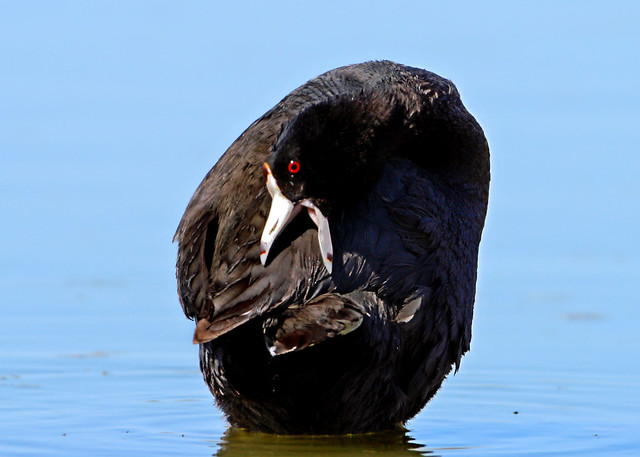
These guys don't get nearly enough credit. They're common, conspicuous, and not very glamorous, so they tend to be the also-rans of the pond. I never go somewhere looking for a coot. If I had to, though, if I didn't already get to see them, I might. Because they're fun.
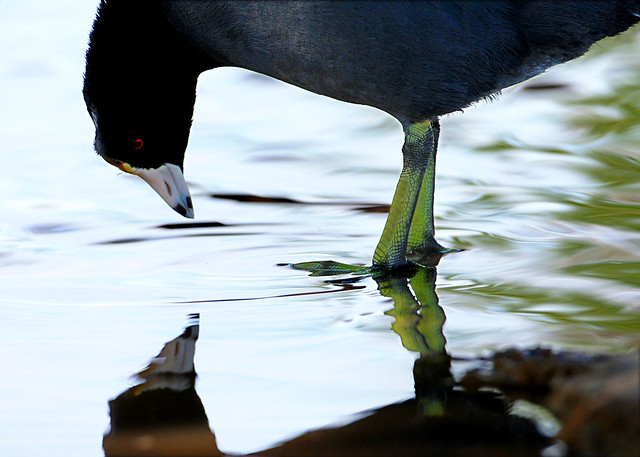
Coots aren't ducks. They're actually members of the rail family, and have uniquely lobed toes, which make them great swimmers but also allow for land mobility. They're feisty and noisy, and if they don't feel like finding their own food (they're omnivorous), they're happy to steal it from other animals.
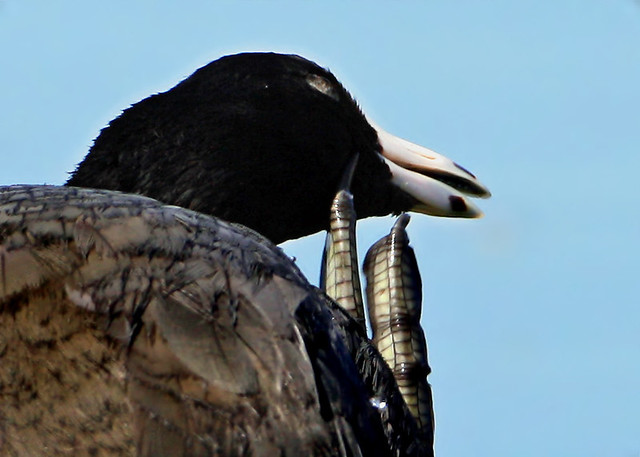
Coots won me over when my husband and I watched a family of them defending chicks from a hungry great egret. I never had known egrets to eat other birds.
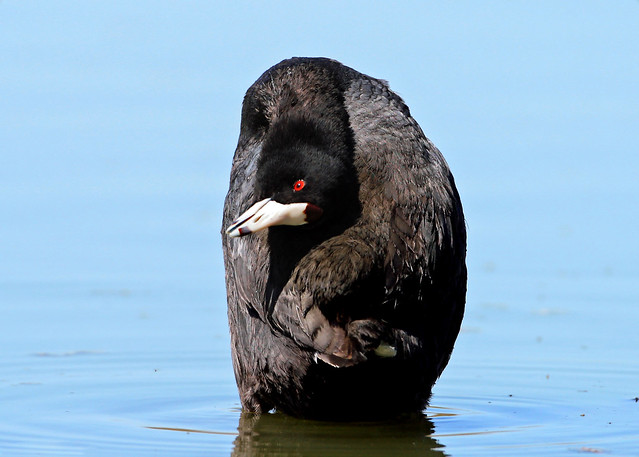 It was a shocker, but more than that, we were struck by the sheer tenacity of the two adult coots. One adult would herd the young into the reeds and try to keep them there, though the brightly colored chicks kept wandering, their bald, red heads like beacons to the hungry egret. The other adult coot would try to attack the many-times-larger egret. It wasn't working. Finally, the egret did snatch a chick, and the two adults launched an all-out, wings-flapping, squawking-grunting attack. The egret kept the baby, but decided the rest weren't worth the trouble, and left. The coots sat with their chicks in the reeds for long minutes afterward, watching the spot where the egret had settled with its small prize. It was sad, but a little amazing too. So coots -- not so boring. And fierce parents.
It was a shocker, but more than that, we were struck by the sheer tenacity of the two adult coots. One adult would herd the young into the reeds and try to keep them there, though the brightly colored chicks kept wandering, their bald, red heads like beacons to the hungry egret. The other adult coot would try to attack the many-times-larger egret. It wasn't working. Finally, the egret did snatch a chick, and the two adults launched an all-out, wings-flapping, squawking-grunting attack. The egret kept the baby, but decided the rest weren't worth the trouble, and left. The coots sat with their chicks in the reeds for long minutes afterward, watching the spot where the egret had settled with its small prize. It was sad, but a little amazing too. So coots -- not so boring. And fierce parents.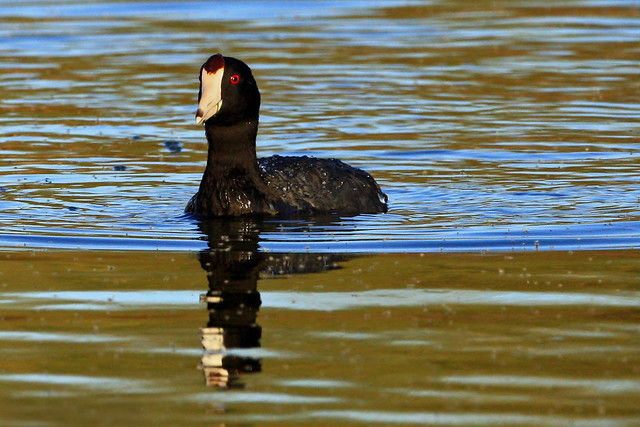
Day 30: Bald eagle, Haliaeetus leucocephalus
Another great bird parent, and an awesome find. Before the recent Internet sensation, I had already been keeping up on the several breeding pairs hatching their own eaglets throughout our state, and I took my camera and son to visit one nest last week.
 We kept our distance, but the eagles saw us. Eagles have two separate centers of focus, so they can look to the side and forward at the same time, and have vision at least four times sharper than a person with perfect eyesight. And since they can spot prey over a miles-wide swath from a thousand feet up, I'm sure it wasn't too much of a feat to spot my son and me.
We kept our distance, but the eagles saw us. Eagles have two separate centers of focus, so they can look to the side and forward at the same time, and have vision at least four times sharper than a person with perfect eyesight. And since they can spot prey over a miles-wide swath from a thousand feet up, I'm sure it wasn't too much of a feat to spot my son and me.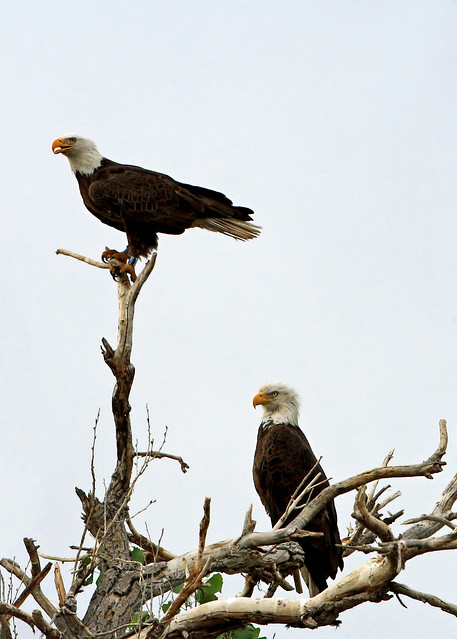 I was really struck by how the two eagles worked as a pair to first watch us and later protect and tend to the chicks. They picked their nest territory well. Two huge branchy trees made up the biggest part, and when we arrived, they were perched on one, scanning the surrounding land. Upon spotting us, they spent a few solid minutes glaring at us from various angles, and finally, one parent glided over to the other tree, where their massive nest sits. The remaining parent was quite content to take up the slack in glaring duty, and even opened its bill a number of times, though neither eagle made a sound. Finally that one, too, went to the nest. The nest itself was obscured unless we tried to get closer, and we didn't want to push it. We just watched. The eaglets were just barely visible, but we could see them moving in the huge bowl, and we could see these two ferocious raptors perched beside the rim of the nest, bobbing their heads in and out gently.
I was really struck by how the two eagles worked as a pair to first watch us and later protect and tend to the chicks. They picked their nest territory well. Two huge branchy trees made up the biggest part, and when we arrived, they were perched on one, scanning the surrounding land. Upon spotting us, they spent a few solid minutes glaring at us from various angles, and finally, one parent glided over to the other tree, where their massive nest sits. The remaining parent was quite content to take up the slack in glaring duty, and even opened its bill a number of times, though neither eagle made a sound. Finally that one, too, went to the nest. The nest itself was obscured unless we tried to get closer, and we didn't want to push it. We just watched. The eaglets were just barely visible, but we could see them moving in the huge bowl, and we could see these two ferocious raptors perched beside the rim of the nest, bobbing their heads in and out gently.It was an amazing family moment, and I don't just mean the eagles. My son has been telling anyone who will listen ever since.
Day 31: European starling, Sturnus vulgaris
What makes a "good" bird? Beauty? Rarity?
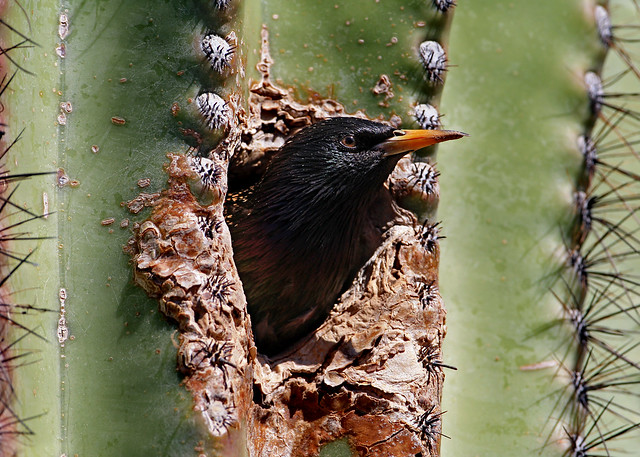
Yes and yes, for many people. Still, just about any bird lover makes exceptions to both of these at one time or another. I love turkey vultures, absolutely love them, despite their not conforming to traditional (or, well, any) beauty standards. (I say they're beautiful, truly. But that's another post.) And I just talked about the coots. Not rare at all.
However, even birders who have their exceptions don't grant one to the European starling. Because they don't belong here. European starlings were introduced to North America in 1890, just 60 to 100 of them, and we now have around 200 million of them in North America. This is supposedly due in part to a brief mention of starlings in Shakespeare's Henry IV. Eugene Schieffelin, a member of the well-intentioned by ill-advised American Acclimatization Society. The society wanted to introduce all kinds of European species to the New World, ostensibly for cultural edification and nebulous economic reasons, but probably because humans tend to think that 1) we can manipulate our environment with impunity; and 2) whatever we've got in our backyards is necessarily the best and should be spread everywhere.
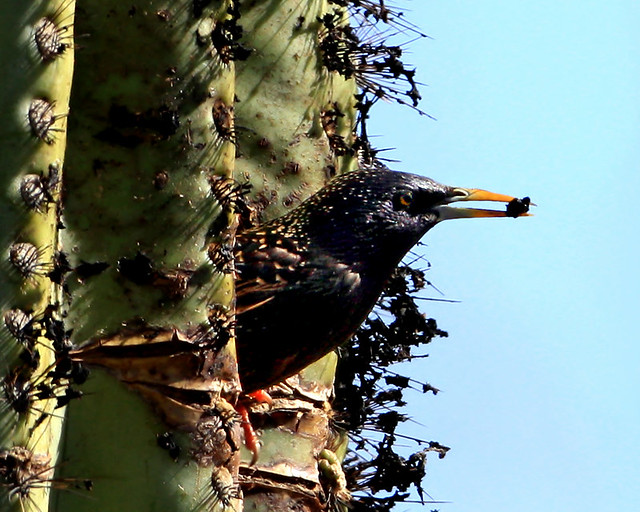 Starling populations exploded, threatening many native bird species. Starlings are hole nesters, and will nest just about anywhere they can -- engines, air conditioners, and grills have all hosted starling nests. But mostly, around here, they steal nest cavities carved in saguaro cacti.
Starling populations exploded, threatening many native bird species. Starlings are hole nesters, and will nest just about anywhere they can -- engines, air conditioners, and grills have all hosted starling nests. But mostly, around here, they steal nest cavities carved in saguaro cacti.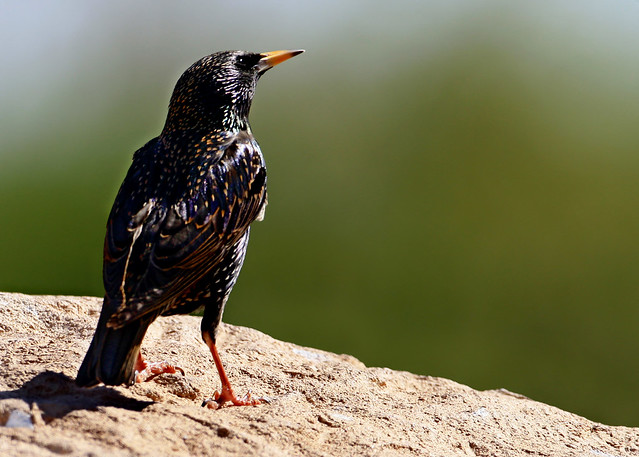 Their excretions can rot damage plants and structures. They're kind of obnoxious. Starling flocks really shouldn't exist in America. Maybe poor Schieffelin wanted just us to feel connected. Since then, we've learned an awful lot about humans' influence on the planet, so in some sense, his lesson succeeded, though certainly not like he intended. We're responsible for what we do on Earth, and sometimes it's a pain. Still, it's not the animals' fault. On an individual level, who can say one animal is more worthy of saving than another?
Their excretions can rot damage plants and structures. They're kind of obnoxious. Starling flocks really shouldn't exist in America. Maybe poor Schieffelin wanted just us to feel connected. Since then, we've learned an awful lot about humans' influence on the planet, so in some sense, his lesson succeeded, though certainly not like he intended. We're responsible for what we do on Earth, and sometimes it's a pain. Still, it's not the animals' fault. On an individual level, who can say one animal is more worthy of saving than another?Day 32: Snowy egret, Egretta thula
It's
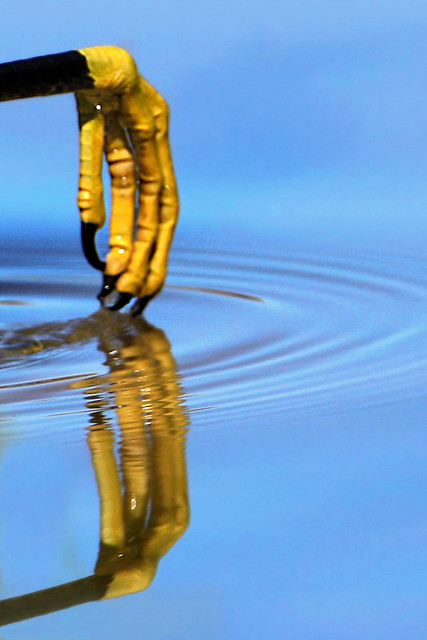 amazing how such similar-looking birds -- I've heard more than a few people
amazing how such similar-looking birds -- I've heard more than a few peopleidentifying these as "babies" of the great egrets, which are an entirely different species -- can act so totally differently. They both eat the same things -- fish, small crustaceans, frogs (though I haven't seen a snowy egret go after coot chicks) -- but the great whites strut. They bully. They're kind of jerks. Snowy egrets are much more cautious. Time after time I've been sitting by the pond photographing birds, and I feel the snowy egret before I see it. I'm sure I actually see the beady yellow eye at the periphery of my vision, but I feel the stare beaming into my head before I really notice the egret. Sure enough, when I look through the reeds, or around the bush, there's the snowy egret, eyeing me suspiciously. They walk with almost comical slow-motion strides and have head plumage seemingly designed for the sole purpose of displaying indignation if their proximity barrier is crossed. This one was very annoyed by a juvenile black-crowned night heron that had the audacity to walk beside it.
Watching them fish is really cool. They're opportunistic, like all herons and egrets -- if a fish swims by, or a frog doesn't notice them, then it's lights-out fish or frog. However, more than the others, snowies add a move to their foraging routine. They'll shuffle along in the shallows, place one foot in the water so it settles halfway into the sediment, and jiggle. And jiggle. After a few rounds of this, they stab up whatever they've agitated into movement. They're better fishers than most people I've seen, and they don't even need to be motivated with a Styrofoam cooler full of Bud Light.
I spent a almost an hour with this egret. Here it is in stare-down mode, which seems to be its primary way of observing the world. Seriously, if i perfected this look, I'm pretty sure my son would always listen to me:
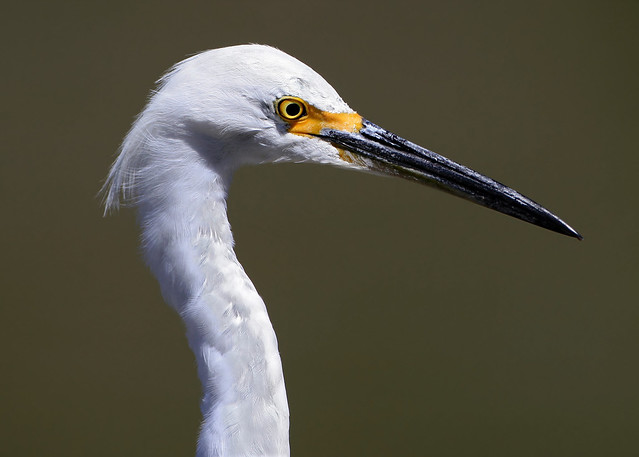
Here it is expressing disapproval. My son would like to inform you that, plumage notwithstanding, I have mastered this expression (I'm not sure how I should take that):
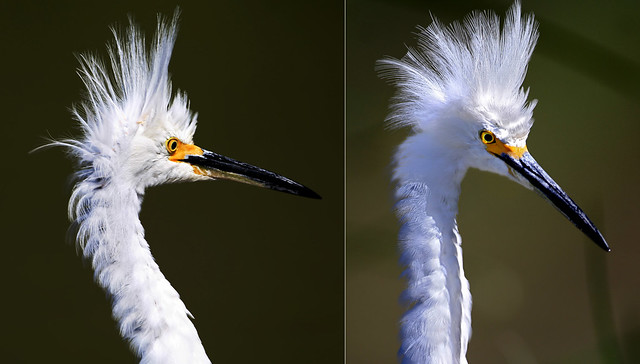
Sometimes it didn't look quite so polished:
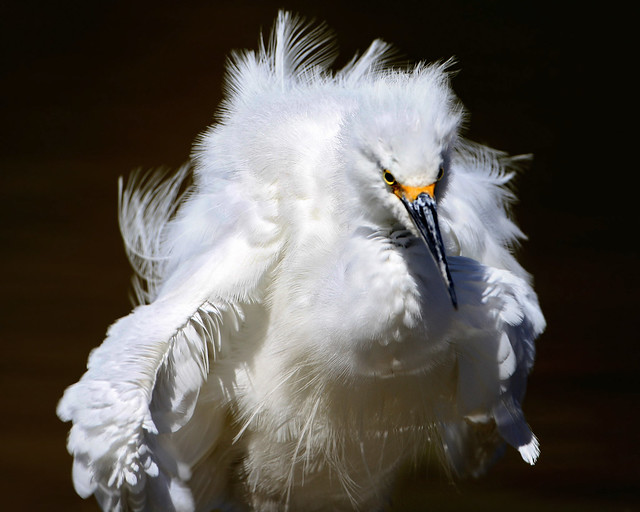
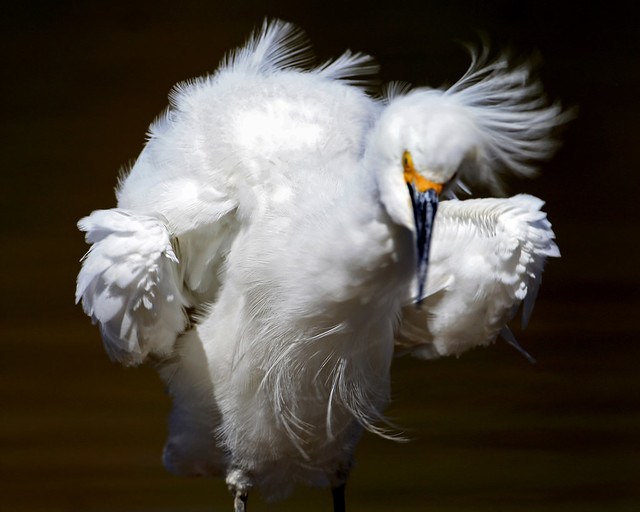
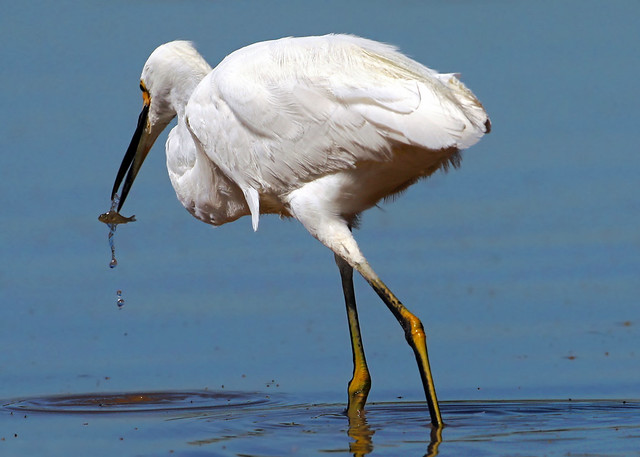
Finally, it tired of me, but I did get to stare back for quite a while.
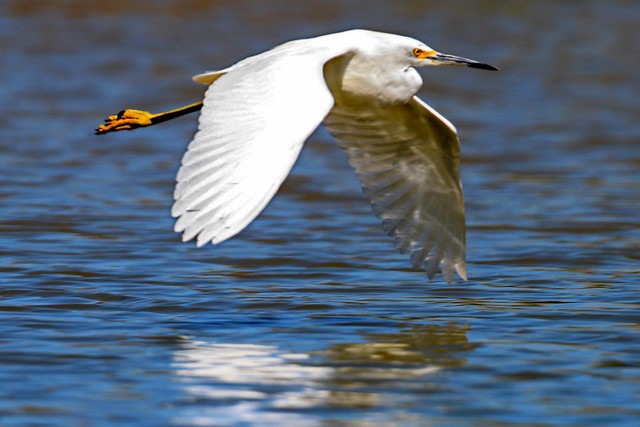
Day 33: Desert cottontail, Sylvilagus audubonii
Hey, look! A mammal! I was starting to think this was turning into "Bird a Day."
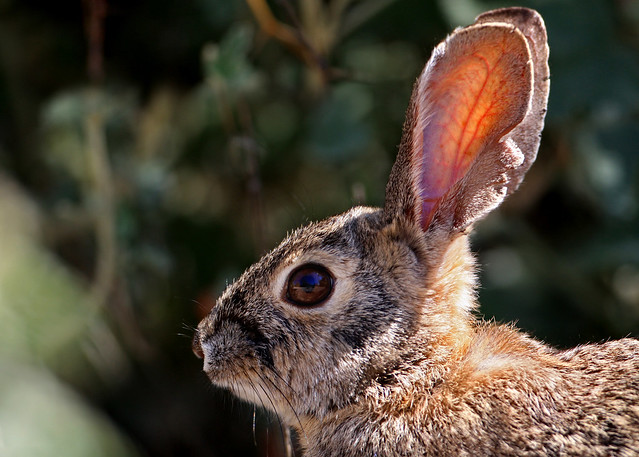 The desert cottontail, like other cottontails, has a little white puffball that is mainly visible as it flees, which is fine, since that's usually what it's doing. These guys are pretty regional, and are really common around grasslands and areas with lots of prickly pear cactus, which they love to eat. Growing up, we'd see tons of pictures of prickly pear cacti with nice round, full paddles, but ours always looked like mangled bits of Swiss cheese covered in spines. We never did much about it, though. The rabbits were too darn fun to watch. They love to play. Their favorite game seems to be to get two of them together, have one stand stock still and have the other one bolt at it. At the last second, the still rabbit will fly vertically, and the hopping rabbit dashes underneath. They never seem to tire of this game, though perhaps they're marveling at the ridiculous apes that never tire of watching them.
The desert cottontail, like other cottontails, has a little white puffball that is mainly visible as it flees, which is fine, since that's usually what it's doing. These guys are pretty regional, and are really common around grasslands and areas with lots of prickly pear cactus, which they love to eat. Growing up, we'd see tons of pictures of prickly pear cacti with nice round, full paddles, but ours always looked like mangled bits of Swiss cheese covered in spines. We never did much about it, though. The rabbits were too darn fun to watch. They love to play. Their favorite game seems to be to get two of them together, have one stand stock still and have the other one bolt at it. At the last second, the still rabbit will fly vertically, and the hopping rabbit dashes underneath. They never seem to tire of this game, though perhaps they're marveling at the ridiculous apes that never tire of watching them.Day 34: Gila woodpecker Melanerpes uropygialis
The Gila
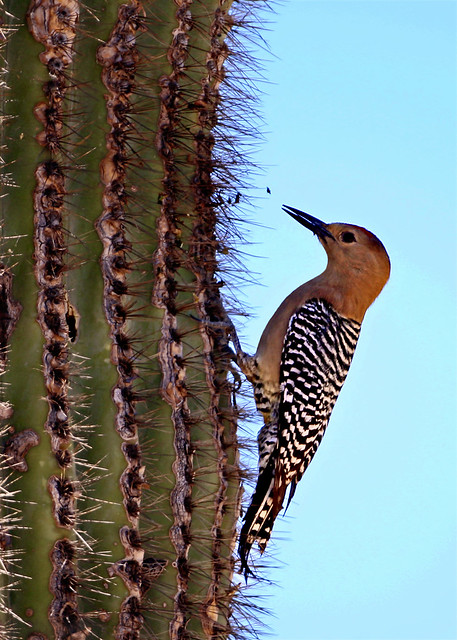 woodpecker is very much a Sonoran Desert bird, and is well adapted to its region. It prefers to carve out nest cavities from saguaro cacti, though it will make homes in other structures. So, even though a few paragraphs ago I was all about Team Starling, I think here I'm edging over to Team Gila Woodpecker, though I hate that it has to be a choice. I'm so drawn to them. The red cap on the males. The striking black-and-white back. The rolling churrrr, cutting into rapid yips when they're alarmed or calling to one another. They're fabulous birds.
woodpecker is very much a Sonoran Desert bird, and is well adapted to its region. It prefers to carve out nest cavities from saguaro cacti, though it will make homes in other structures. So, even though a few paragraphs ago I was all about Team Starling, I think here I'm edging over to Team Gila Woodpecker, though I hate that it has to be a choice. I'm so drawn to them. The red cap on the males. The striking black-and-white back. The rolling churrrr, cutting into rapid yips when they're alarmed or calling to one another. They're fabulous birds.Curiously, research seems to indicate that Gila woodpeckers are uniquely threatened by nest cavity theft. Starlings seem to compete with them and drive their numbers down, but don't have the same effect on northern flickers, another Arizona woodpecker. I think it might have something to do with the preferred territories of the Gila and flickers -- saguaro-rich and ironwood-rich, respectively. Unfortunately for the Gila woodpeckers, starlings prefer their neighborhoods.
Day 35: Cinnamon teal: Anas cyanoptera
("Cinnamon teal? Is that a dessert?" --My husband)
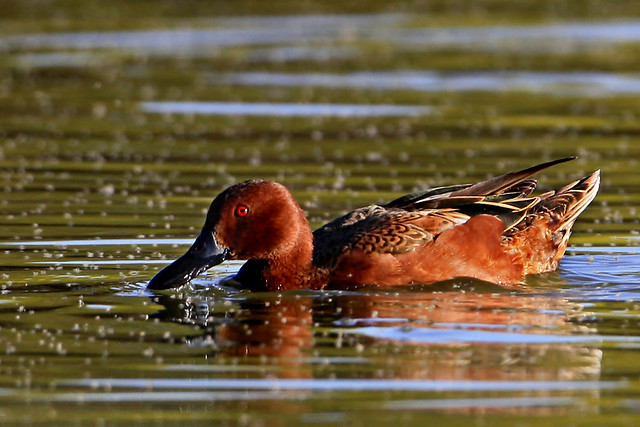 Who said ducks are boring? These guys are radiant. Cinnamon teals winter and breed in Arizona occasionally, but are more often seen as migrants. We spotted these at the Gilbert Riparian Preserve. In the evenings, massive clouds of bugs cover everything. Like, everything everything. I was bent over taking pictures. My son called my name. In turning around, drawing a breath, and saying "What?" I inhaled a dozen bugs and swallowed a dozen more. (He was telling me that there were bugs around my head. Thanks, son.)
Who said ducks are boring? These guys are radiant. Cinnamon teals winter and breed in Arizona occasionally, but are more often seen as migrants. We spotted these at the Gilbert Riparian Preserve. In the evenings, massive clouds of bugs cover everything. Like, everything everything. I was bent over taking pictures. My son called my name. In turning around, drawing a breath, and saying "What?" I inhaled a dozen bugs and swallowed a dozen more. (He was telling me that there were bugs around my head. Thanks, son.)Well, these guys gobble the bugs up by the hundreds. All those specks on the water? Bugs. The teal? A bug vacuum. My hero.
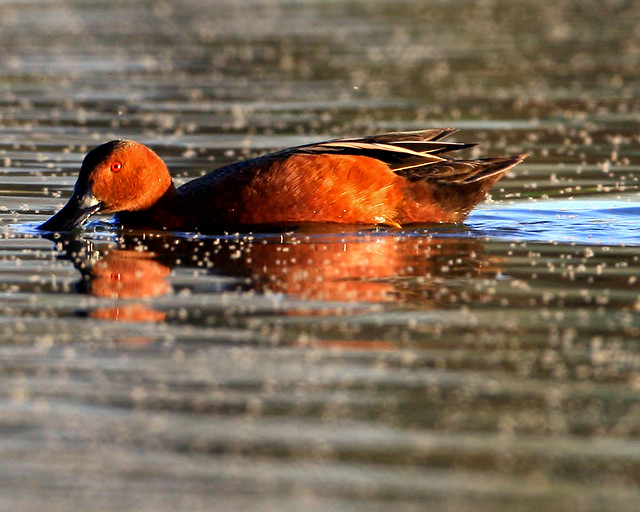 They also eat plants, which I believe make up the majority of their diets. Perhaps this one saw me taking a crack at the bugs and figured he'd better eat them while he could.
They also eat plants, which I believe make up the majority of their diets. Perhaps this one saw me taking a crack at the bugs and figured he'd better eat them while he could.That's it for this week. This paying attention to animals thing is seriously fun. Let me know what you're seeing in your neck of the woods (or desert, or pond, or backyard, or puddle) too!
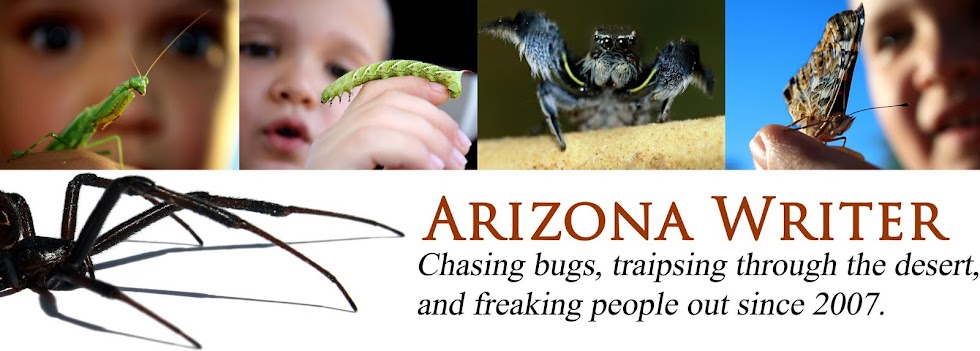
10 comments:
Thank you for sharing not only your brilliant photos but also some great information about the various species you shoot.
Thank you! It really is just a fun way to learn about the animals we see all the time anyway. (Well, except for the eagles. That was a bit of a treat.)
I am so jealous of your pictures.
I really can't stand it. I almost can't look anymore.
I am pathetic! But you are fabulous.
Leslie: XOXO. Thank you. You know I don't think you're pathetic, not least of all because you surpass me in several ways.
Coots! We've got gobs of them over on our local lake. I've loved them ever since I saw a mama one stuff tons of green plant material into its baby's mouth. "Eat your spinach..."
Information and photos are super - so glad I looked! Have a great weekend - see you round the pond?
Christina: I've seen them do that! One day, my son and I had just been talking about how strict parenting can be for one's own good (or rather, I'd been talking about it), right before we saw such a display. Way to prove Mom's point, nature.
Lou: Thanks, and so glad you stopped by! I'm sure we'll be seeing each other around the pond eventually, hopefully before the temps reach boiling again this year!
You're an amazing photographer! God bless that talent, I really enjoyed the pictures and the fact that you also give details about the animals you shoot is really great! :D
Post a Comment